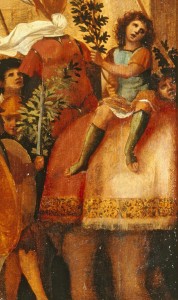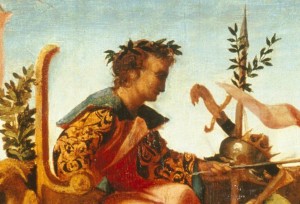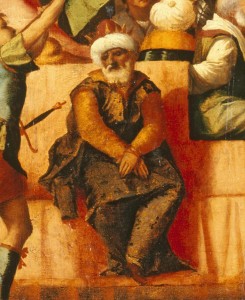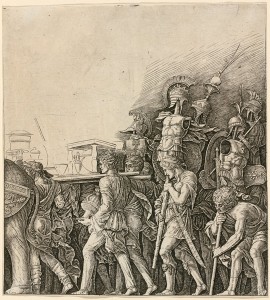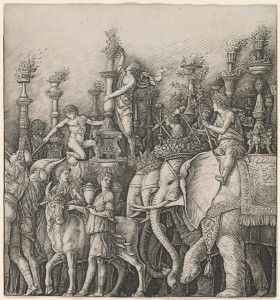
Paolo Uccello
Episodes from the Aeneid, c. 1470
Egg tempera, oil, and gold on wood panel, 41 x 156.2 cm (16 1/8 x 61 1/2 in.)
Seattle Art Museum, Gift of the Samuel H. Kress Foundation
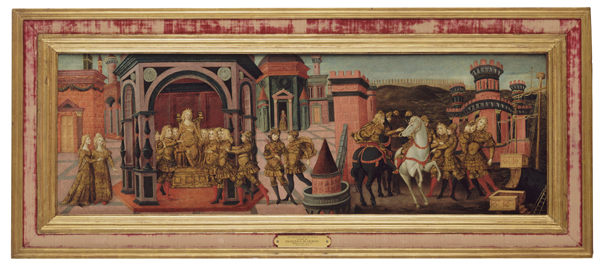
Studio of Franceso di Giorgio Martini
The Meeting of Dido and Aeneas, c. 1480
Tempera on wood, 37.5 x 110.2 cm (14 13/16 x 43 7/16 in.)
Portland Art Museum, Gift of the Samuel H. Kress Foundation
In Comparison of Old and New Rome (1411), Manuel Chrysoloras called attention to the fact that ancient Roman sculpture could provide vivid snapshots of antique costumes, customs, and the like:
One can see clearly what kinds of arms the Ancients had, what kind of clothes they wore, what the devices of their rulers were, how they formed lines of battle, fought, laid siege, and built encampments. …Herodotus, and some other historians, are thought to have made useful contributions to our knowledge of such things. But these reliefs show how things were in past times and what the differences were between the peoples. Thus they make our knowledge of history precise or, rather, they grant us eyewitness knowledge of everything that has happened just as if it were present.5
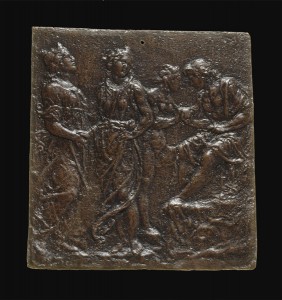
Francesco di Giorgio Martini
The Judgment of Paris, c. 1475/1485
Bronze/dark patina (black lacquer somewhat rubbed over rich reddish-brown bronze), 13.7 x 13 cm (5 3/8 x 5 1/8 in.)
National Gallery of Art, Washington, DC, Samuel H. Kress Collection
Image courtesy of the Board of Trustees, National Gallery of Art
Several decades after Chrysoloras made these observations, artists began scrutinizing antique relief sculpture for authentic historical details. Prior to that, they had tended to depict the history and legends of ancient Greece and Rome using costumes and archaeological settings of more recent times.
For example, early Renaissance depictions of the Aeneid (19 BC), an epic account of the founding of Rome by the poet Virgil (70–19 BC), characteristically feature crenellated castles and elegant figures seemingly lifted from a medieval chivalric romance. Graceful Amazon warriors do battle with courtly Trojan soldiers in Episodes from the Aeneid, c. 1470, a cassone panel by Paulo Uccello. Simulating the rich patterning and surface decoration of the late Gothic period, the artist lavished attention on such practical details as ship rigging, equestrian equipage, and helmet design, without evident reference to ancient prototypes.
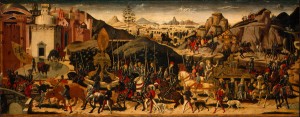
Biagio d’Antonio and workshop
The Triumph of Camillus, c. 1470/1475
Tempera on panel, 60 x 154.3 cm (23 5/8 x 60 3/4 in.)
National Gallery of Art, Washington, DC, Samuel H. Kress Collection
Image courtesy of the Board of Trustees, National Gallery of Art
Francesco di Giorgio Martini was among the first artists to cultivate an impression of archaeological verisimilitude in depictions of ancient subject matter. An innovative artist as well as a brilliant engineer and architect, Francesco was well equipped to respond to the rising taste for the antique in his native Siena—a city beginning to take pride in its ancient Roman origins. His influence is evident in the eye-catching pseudo-Roman buildings that signify Carthage in The Meeting of Dido and Aeneas, a cassone panel produced by his studio in about 1480. According to Virgil, the city dazzled Aeneas and his men. Though founded only recently by Dido, Carthage already featured an extensive network of walls and gates, lofty towers, a citadel, and a golden shrine to the goddess Juno. Francesco adopted many of these details in his painting. The hexagonal temple of Hera, in the left foreground, conveys an impression of the grandeur of Carthage through its inlaid marble ornaments and medallion-shaped relief carvings. Enthroned within the temple, Queen Dido greets Aeneas and the other Trojans who disembark from the ship at far right. The lines of the inlaid marble pavement impose rational order on the expansive and spatially ambiguous cityscape.
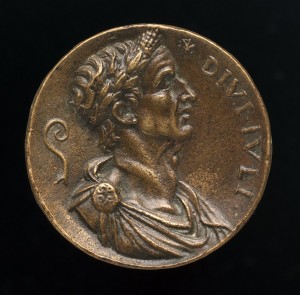
16th-century Italian, after ancient model
Julius Caesar
Bronze/light brown patina, diameter 4.1 cm (1 5/8 in.)
National Gallery of Art, Washington, DC, Samuel H. Kress Collection
Image courtesy of the Board of Trustees, National Gallery of Art
Apart from these self-conscious allusions to the antique, the painting relies on Gothic and Renaissance materials. The towers and spires in the distance and the crenellated fortress at far right present a fantastic patchwork of Gothic and Renaissance architectural styles. The elegant figures have more in common with medieval tapestry than with ancient sculpture. The confusion of styles perhaps reflects the number of hands participating in the work, for Francesco relied on workshop assistants to keep pace with the burgeoning demand for his paintings. His sculptures, by contrast, appear to have been more independent efforts. The Judgment of Paris, a bas-relief of c. 1475–80 , demonstrates a sophisticated and sensitive approach to classical conventions in its idealized treatment of the draped human body.
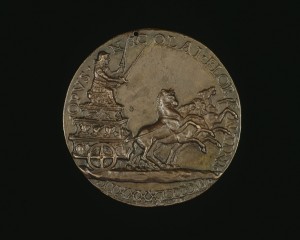
Niccolò Fiorentino
Alfonso (?) in a Triumphal Car, 1492
Bronze, diameter 7.1 cm (2 13/16 in.)
National Gallery of Art, Washington, DC, Samuel H. Kress Collection
Image courtesy of the Board of Trustees, National Gallery of Art
Representing ancient Carthage required an imaginative leap. In representing ancient Rome, however, artists found themselves on familiar turf. In the painting the Triumph of Camillus, c. 1470/75, Biagio d’Antonio rendered the city of Rome by means of a capriccio, an architectural fantasy, combining famous landmarks and invented architecture. At left are two immediately recognizable Roman buildings, the Pantheon and the Mausoleum of Hadrian, hemmed in by an assortment of pseudo-classical and Renaissance structures. The representation of Camillus also relies on antique prototypes. His head (in profile, encircled by a laurel wreath) resembles portraits of Roman emperors on ancient gems, coins, and medals. Modern bronze copies were widely available, such as an early sixteenth-century plaquette representing the laureated bust of Julius Caesar, possibly based on an antique intaglio in the Medici collection.
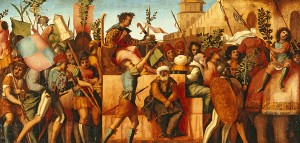
Jacapo Palma il Vecchio
The Triumph of Caesar, c. 1510
Oil on wood, 69.5 x 145.7 cm (27 3/8 x 57 3/8 in.)
Lowe Art Museum, University of Miami, Gift of the Samuel H. Kress Collection
Biagio’s painting concerns the republican hero Marcus Furius Camillus (c. 446–365 BC), whose military accomplishments had earned him the epithet of Second Founder of Rome. On four occasions, he was granted the supreme privilege of a Triumph, a public procession honoring the exceptional martial achievement of a military commander or emperor. In design and elaborate ornamentation, the chariot deviates from the simple rigs that appear in ancient sculptural representations of Roman triumphs. Most likely, Renaissance viewers would have associated it with an object of more recent vintage: the extravagantly decorated floats that paraded through the streets of Florence during public pageants held on feast days and other special occasions. An example of such a splendid triumphal vehicle is seen in a medal created by Niccolò Fiorentino to commemorate Alfonso d’Este’s visit to Florence in April 1492. The contemporary Renaissance costumes in Biagio’s painting also would have struck a chord of recognition, further enlivening the remote historical subject with a sense of familiarity and relevance. The linking of past and present was in fact an important subtext of Renaissance depictions of famous antique heroes such as Camillus, who were held up as timeless and universal examples of virtuous conduct. Commanding attention through its large size and vivid imagery, the Triumph of Camillus would have provided a striking focal point in the private palazzo of a wealthy family—an impressive billboard advertising both the good character and the classical erudition of the patron. (Read Showing off an antique sculpture garden.)
Increased knowledge of antiquity steadily raised the standard of historical authenticity in Renaissance images of the ancient past. The Triumph of Caesar, c. 1510, attributed to Palma Vecchio, is one of three panels illustrating episodes from the life of Caesar that may once have constituted a frieze. Here again, the depiction of a famous historical figure—the greatest soldier of the Roman era—would have conferred an aura of righteous virtue on the patron who displayed it. The painting represents a complex amalgamation of ancient and modern archaeological and textual sources. As in Biagio’s Triumph of Camillus, contemporary Florentine pageants and processions may have influenced the festive imagery, but discrete details appear to derive from authentic Roman sources. For example, Caesar’s laurel-wreathed head imitates the clearly incised, low-relief profile portraits in ancient coins, medals, and gems. A well-known Trajanic statue of a Barbarian captive may have provided the model for the captured Ottoman in exotic turban and full beard who sits in sad submission on Caesar’s car. Ancient literary accounts of Roman triumphs presumably informed other details, such as the elephant at far right, which recalls Suetonius’s description of the lamp-bearing pachyderms that illuminated Caesar’s triumph.
![Andrea Andreani, after Andrea Mantegna<br /><i>The Triumph of Julius Caesar</i> [nos. 5 and 6 plus 2 columns], 1599<br />Chiaroscuro woodcut<br />National Gallery of Art, Washington, DC, Rosenwald Collection<br />Image courtesy of the Board of Trustees, National Gallery of Art](http://italianrenaissanceresources.com/wp-content/uploads/2012/12/RP_175-300x137.jpg)
Andrea Andreani, after Andrea Mantegna
The Triumph of Julius Caesar [nos. 5 and 6 plus 2 columns], 1599
Chiaroscuro woodcut
National Gallery of Art, Washington, DC, Rosenwald Collection
Image courtesy of the Board of Trustees, National Gallery of Art
